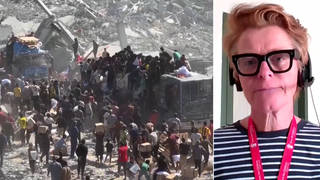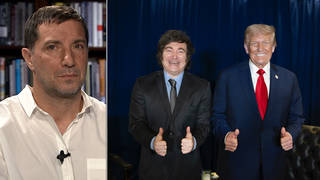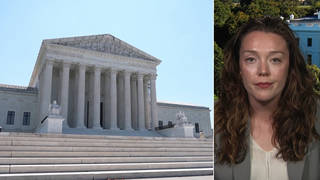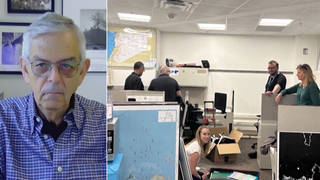
Guests
- John Hickenloopermayor of Denver.
- Damon MoglenGlobal Warming Campaign Director for Greenpeace USA.
The Obama administration has moved a step closer to regulating greenhouse gases. On Monday, the Environmental Protection Agency said six gases, including carbon dioxide and methane, endanger the environment and public health. The move would allow the EPA to take action against greenhouse gases without needing congressional approval. We host a discussion on US climate change policy with Damon Moglen, global warming campaign director for Greenpeace, and John Hickenlooper, the mayor of Denver. [includes rush transcript]
Transcript
AMY GOODMAN: The Obama administration has moved a step closer to regulating greenhouse gases. On Monday, the Environmental Protection Agency said six gases, including carbon dioxide and methane, endanger the environment and public health. The move would allow the EPA to take action against greenhouse gases without needing congressional approval.
EPA administrator Lisa Jackson made the announcement Monday at a news conference in Washington.
LISA JACKSON: Today’s action is a step towards enduring, pragmatic solutions to the enormous challenge of climate change. It is a step towards innovation, investment and implementation of technologies that reduce harmful emissions.
AMY GOODMAN: The EPA announcement came on the first day of the COP15 climate summit here in Copenhagen. The European Commission applauded the decision, saying it would be a boost to the negotiations aimed at crafting a new global agreement to curb greenhouse gases.
President Obama is attending the talks on the summit’s last day. He is expected to commit the US to an emissions cut of 17 percent by 2020 compared to 2005 levels. That falls far short of the cuts recommended by the world’s top scientific body on global warming, the UN Intergovernmental Panel on Climate Change. They’ve called on developed countries to cut emissions by between 25 to 40 percent of 1990 levels.
For a discussion on US policy on climate change, we’re joined by two guests. John Hickenlooper is the mayor of Denver. He is participating in a panel discussion on the role of public transportation in reducing carbon emissions. He won the 2009 Mayors’ Climate Protection Award for a large city. And Damon Moglen is with us. He’s the global warming campaign director for Greenpeace USA.
We welcome you both to Democracy Now! Damon, let’s begin with you. The significance of the EPA’s decision, carbon dioxide and methane among the six gases considered dangerous?
DAMON MOGLEN: Well, I think that this is an important step, but it’s only a step. It’s only a first step, really, in a regulatory process that needs to move ahead very, very rapidly.
At the same time, I think it’s hard not to see the timing of the announcement as a very political one. The fact is the US arrives at Copenhagen putting very little on the table. In fact, right now the US is really the number one impediment in these negotiations.
And other countries are demanding more. They want to see the US having much stronger emissions reductions, and they want to see money on the table for the developing countries who are on the cutting edge of climate change. And in all reality, this announcement does not increase either of those things, nor does it begin the process of immediately regulating greenhouse gases in the United States.
AMY GOODMAN: Just clarify this issue of 17 percent, 20 percent, 1990, 2005. I think we’re going to have to address this every day.
DAMON MOGLEN: Well, I’m afraid we do have to address it every day. It’s really very sad, because the entire planet is really operating on the idea that we need to be using 1990 target levels and baseline. The entire scientific community is using this 1990 level. The United States and the Obama administration have now announced, “No, we’re going to use the 2005 base level.” So what we now have is a very confusing situation, with everybody in the world using a series of numbers and the US using a different series of numbers.
AMY GOODMAN: So that when we say people are calling for 20 to 45, 49 percent, and the US is proposing 17, that 17 doesn’t compare to the 20, because that doesn’t sound so bad.
DAMON MOGLEN: It does not compare in any way.
AMY GOODMAN: Why?
DAMON MOGLEN: The real figure is that the US is putting on the table an emissions reduction of four percent, as compared with 25 to 40 percent that the international science community is telling us we need to have by 2020 to stop catastrophic climate change.
AMY GOODMAN: Mayor Hickenlooper, what about the US position? First, address the EPA and then this issue of what the US brings to the table here.
MAYOR JOHN HICKENLOOPER: I think the EPA stepping in — clearly CO2 and methane, these six gases, are pollutants. There can’t be any question, so I don’t think there’s a — there shouldn’t be a lot of discussion about whether the EPA has the jurisdiction or the authority. I think the devil will be in the details. How do they move forward? What kind of regulations do they create? Do they avoid some of the bureaucracy and find those places where they can be effective and efficient?
You know, the problem with the United States, the reason President Obama is in such a difficult position, is somehow we are still so polarized over this issue, after all this study and so much science. I mean, science — you know, in my previous life, I actually was an — I got a Master’s in geology, in earth science, earth and environmental science. And it’s messy. It’s hard, right? There’s a lot of noise and chatter. There’s always going to be some debate about a specific data set here or data set there. But we need to bring those skeptics — that means — some are so unreasonable that you can’t put more time in them. But a lot of the skeptics, we need to bring them together, sit down, and continue to work through this and bring them over to our side, because I think there’s a reason why Obama — it’s not because he’s a coward or he’s a, you know —- 17 percent is something he felt that he could sell. And -—
AMY GOODMAN: Four percent.
MAYOR JOHN HICKENLOOPER: Well, exactly, but the number that he thought he could sell in the United States, which is a minimal number, right? It’s a much smaller, more modest target than anyone really who’s dealing with the problem is comfortable with. And yet, politically, in our — in the United States today, you know, it reminds me a little bit of slavery, of Lincoln having to deal — if you look how moderate Lincoln was, you know, in 1856, 1858, 1859, even as he was getting elected. I mean, it’s an intergenerational problem that has been, you know, intensely polarizing.
And I think what Obama is trying to do is thread the needle and bring the country together around this issue. And I think my belief of this is nothing — I have no inside knowledge, but I think he’s trying to find some moderate goals that we can all accept, agree as a country, this is a problem, here’s a target, we’re going to move forward, and then accelerate that as he gets a broader consensus.
AMY GOODMAN: You quoted Abraham Lincoln yesterday when I bumped into you in the hallways here at the Bella Center.
MAYOR JOHN HICKENLOOPER: Well, one of Lincoln’s — when Lincoln was first — the first Lincoln-Douglas debate, someone asked him — he was running for the Senate in 1858, long before anyone ever thought he’d be president. I mean, he lost that bid for the Senate. And they asked him whether — maybe he should be considering the Supreme Court. And Lincoln said that they were missing the point, that it was about public sentiment. And he said, “With public sentiment, nothing can fail; without it, nothing can succeed. That is why those who mold public sentiment go deeper than those who enact statutes — legislators — or those who pronounce decisions — judges.” And I think that’s part of why Obama might be the right person at the right time, is that he really is trying to mold public sentiment first and recognizes that as critically important.
AMY GOODMAN: Damon Moglen of Greenpeace?
DAMON MOGLEN: Well, I think — I think the President does indeed have a very difficult situation on his hands. I think that the fossil fuel industry has been very effective at writing the climate legislation right now in the United States. We have a situation in which the legislation in the Congress hands out billions and billions of dollars to the coal industry, the very people that got us in this trouble, but does not invest adequately in green technology and efficiency technology. The Congress has not given Mr. Obama what he needs to come to these negotiations and act in an ambitious way.
And I think he’s challenged right now to make a very critical decision. As the President of the United States, he has huge powers that he could be using to directly begin to bring down emissions and bring money to the table. And I think the real fear is that if he doesn’t do that, if he does not act in the dramatic leadership way that he could be, these negotiations will yield very little or they could break down.
AMY GOODMAN: What could he do?
DAMON MOGLEN: Well, I think that, for example, through the EPA, we could actually see direct regulation of the fossil fuel industry. We could begin, over these next years, to begin to really bring down emissions. We could stop constructing new dirty fossil fuel facilities. Earlier in the program, you talked about brand new facilities opening. How can we talk about recognizing climate change and continue to open the very facilities that we know are creating climate change? So, Mr. Obama can do a tremendous amount. He does not need to be waiting for the Congress. In fact, the Congress is getting in the way of him leading.
AMY GOODMAN: This decision yesterday, the EPA classifying carbon and methane dangerous to public health, does it change what can happen in terms of legislation or White House edict?
DAMON MOGLEN: Well, I think that that’s a very good question, and I think it’s a question that Mr. Obama has to answer. The press release was written in a very careful way yesterday. It makes very clear that the President, in fact, is calling on Congress to legislate our response to climate change, and it makes clear that the announcement is made because the Supreme Court told them to issue this announcement.
The big question is, Mr. Obama now needs to say, quite categorically, “I am going to regulate greenhouse gases using the EPA.” And he needs to come here to Copenhagen and say, “Given that we can regulate directly now, I can give you a much higher emissions reduction level, and I’m ready to put that on the table.”
AMY GOODMAN: ”We can regulate direct” — I mean, the EPA can just do it without congressional legislation?
DAMON MOGLEN: Under our Clean Air Act, they can do it, and the Supreme Court told them, “Get doing it.”
AMY GOODMAN: What do you think of this, Mayor Hickenlooper?
MAYOR JOHN HICKENLOOPER: I’m not sure I’d go quite that far that that was what the Supreme Court was saying, although I’m not a lawyer, so I would yield to those with higher powers.
You know, I look at some of the ways that the Obama administration, they’re doing things that no other administration has done. You know, he talked to lobbyists that had been working in Washington for fifty years. It’s the first time that the EPA is working hand in glove with the Department of Transportation and with Housing and Urban Development, with HUD, so that if they’re going to give a billion dollars to a city to build a transit system, how do they make sure that they get changes in zoning and greater density around each of those transit stops? How do they make sure they have affordable housing at each of these transit stops? How do they make sure they take brownfield sites at old factories and build these new small villages there?
I mean, those are the kinds of things that, long term, in cities across America, are going to make dramatic changes and help us reach these ambitious goals. And they’re already doing that; they’re not waiting to legislate that. They’re saying, “Alright, how do we get more money for transit? How do we focus our energies on integrating the federal agencies so that we can begin moving it?” Because it is. It’s just an enormous challenge for everyone. They’re not waiting. They’re already doing it.
AMY GOODMAN: This is why you’re actually here in Copenhagen, is that right?
MAYOR JOHN HICKENLOOPER: Well, the transit side of it, right. We’re talking about what are those ways that you integrate transit with bicycles. I mean, here we are in Copenhagen. Thirty-seven percent of the people in this city, when they go to work in the metropolitan area, ride a bicycle to work. I mean, it’s remarkable. Their goal — I met yesterday for an hour with the deputy mayor of the environment and transportation, Klaus Bondam, and Klaus Bondam described how their next goal is to hit 50 percent. I mean, to have half your population, when they go to work on bicycles, they’re healthier, the air is cleaner, there’s less carbon emissions, you save money. I mean, the benefits are dramatic, and you can see the difference just when you walk down the street.
AMY GOODMAN: I mean, we were just in the city council last night at like 10:30, 11:00. The whole bottom floor of this century-old building is filled with not only bicycle racks, but bicycles that fill them.
MAYOR JOHN HICKENLOOPER: Right.
AMY GOODMAN: And city council members, the guards, everyone are riding in and out of the city council on their bicycles.
MAYOR JOHN HICKENLOOPER: Yeah. When I flew in, the fellow next to me on the plane is a hotshot young technology expert, makes a huge amount of money — doesn’t own a car, rides his bike. You know, he says, “It’s healthier. It’s more fashionable.” It’s — you know, it’s what his friends do. And I think that’s the whole thing that — when you get to public sentiment, I mean, what Lincoln was talking about. We need to change our public sentiment so people want to do these things. And it’s not government coming down and being punitive, but it’s creating a change, a transformation in our attitudes.
AMY GOODMAN: Damon Moglen, do you think the press is creating that — the education necessary for change, when you have a media in the United States, for example, brought to us by Exxon Mobil, brought to us by Chevron, brought to us by BP?
DAMON MOGLEN: Yeah, no, I don’t, unfortunately. I think that we are not seeing the kind of coverage that we need to be seeing. And I think at the same time that Mr. Obama himself needs to step up and talk more about climate change. It’s obviously correct that he’s needed to spend a good deal of time talking about healthcare reform in our country, and it’s a very important issue, but unfortunately he’s done that to the real neglect of talking about climate change. And I think we see the ways in which he could be talking about it much more. He could be bringing the public along. I agree with the analogy to Lincoln; I think it’s very important. The only way we are going to have these kind of changes in the United States is if the public moves along with the policymaking process.
AMY GOODMAN: Damon, the issue of climate debt, please explain it, what this means, from the developing world — or from the developed world to the developing world, and where the US stands on this. It is a major issue, one of the major threads that are going through this conference right now and creating a lot of anger.
DAMON MOGLEN: Well, that’s right. I mean, I think you can have no better example than the younger person you had on earlier on your program. I think that what we have to realize is that there are many countries around the world right now that are experiencing catastrophic effects from climate change, be it sea rise, be it their crops are wilting, be it their livestock are dying, being massive refugee problems now. And this is happening now. And the fact of the matter is that the developed countries, and in particular the United States, created the historical pollution that creates these problems in the developing world. It’s not these small countries that have created the greenhouse gas problem.
So what we have now is one of the key issues here in Copenhagen, is that the developed countries are going to have to fund what is called adaptation and mitigation in the developing countries. They also need to fund the protection of forests around the country — around the world. And this is a critical part of the agreement that has to be reached here. And as much as $140 billion a year may well be the price tag for doing this. And what needs to be realized is that if we don’t spend that kind of money, if we do not help the developing countries and the countries on the front lines of climate change, there will need to be even more gigantic sums of money that will have to be paid in the future in order to deal with these catastrophic problems.
AMY GOODMAN: What has the US pledged?
DAMON MOGLEN: The US pledge, in fact, going into Copenhagen, is zero. The US has not categorically stated that it is prepared to put any money on the table. The expectation is that the US will put somewhere in between half a billion and maybe a couple of billion dollars. This is pennies on the dollar of what’s needed, absolutely pennies on the dollar of what’s really needed. The US should be putting much more of a commitment financially. And you see other countries being ready to put much more money on the table, in the tune of tens of billions of dollars from Europe, for example.
AMY GOODMAN: When I saw you yesterday, the Ex-Im Bank had just made a big announcement, the US Ex-Im Bank.
DAMON MOGLEN: Well, that’s right. I think this is a remarkable comparison. Yesterday it was announced that the US government is going to be providing, through Ex-Im Bank, three —-
AMY GOODMAN: Export-Import.
DAMON MOGLEN: The Export-Import Bank -— $3 billion for the creation of an Exxon-subsidized project, an Exxon-run project in Papua New Guinea. For that same $3 billion, if the United States were putting that and more on the table here at Copenhagen, we would be going a long way towards getting the deal we need. And yet, very easily, we can give that money to an Exxon project, but we’re not giving it to these countries.
AMY GOODMAN: Why do you think President Obama is not being a leader in this area?
DAMON MOGLEN: Look, I think that the President is walking into a government that has been moving in a certain direction from the past administration, and it’s hard to yank it around. But yank it around he has got to do now, and particularly with the time constraints of these negotiations. He needs to make some real decisions about what he can bring to the table now, because if we don’t bring enough, the negotiations could fail here.
AMY GOODMAN: Mayor Hickenlooper, who do you think President Obama is surrounding himself by? What stops him from taking more of a leadership role here? Though he did say he’s not coming this week, he’s coming next week, which many feel is more significant.
MAYOR JOHN HICKENLOOPER: Right, that was a remarkable willingness to adapt to the situation, changing his schedule, saying, “I’m going to come later. We’ll make it where I can have the potential.” He has greater risk, but he has greater potential to kind of bring everyone together.
Again, I think his greatest challenge — he’s surrounded himself with a bunch of — with some real talent. If you go down and look at NOAA, at NREL, the Renewable Energy Laboratory, a lot of the scientific arenas he has populated with very talented, very experienced, worldly scientists. But again, he’s got to move within public sentiment, within that sense.
And a lot of issues — I mean, the whole question about extreme climate change as being the direct result of greenhouse gases, the argument that continually gets put back is, look at the Dust Bowl in the Great Depression, right? And that was before we had anywhere like these types of CO2 buildup. How do you tell which dramatic climate changes are the result of CO2 emissions and greenhouse gases and which ones aren’t? And that’s — you know, that level of scientific application is still — I mean, I think most people agree that the modeling is — again, it’s hard work. There’s a lot of noise on it. I think the — I think what the real key is, we know that climate change is occurring. Alright, everyone knows that. We know it’s dramatic. We know that mankind is the likely — the vast majority of it is a result of our actions. So we need to address it and move quickly. I think when you start trying to break down which part of the climate disruption is the consequence of which pollution images or who’s responsible, that’s when we get into trouble, though certainly, dramatically, we need billions of dollars, though.
AMY GOODMAN: We have thirty seconds. Greenpeace’s demands here at the COP15 summit?
DAMON MOGLEN: We need to have emissions reductions brought to the table by the President that’s in line with the science. It needs to be much larger. He also needs to bring a much larger commitment to the table in terms of financing. And the President needs to publicly, openly dedicate the United States to coming here and getting a legally binding agreement.
AMY GOODMAN: We’re going to leave it there. I want to thank you, Damon Moglen, for joining us, global warming campaign director at Greenpeace USA, and John Hickenlooper, mayor of Denver. He won the 2009 Mayors’ Climate Protection Award for a large city.












Media Options